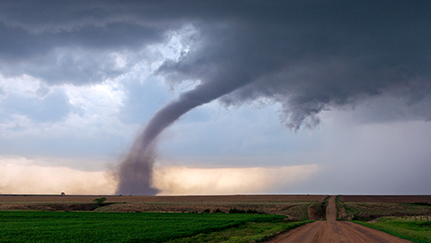A proactive approach to catastrophes

Does it seem like there are more natural disasters than ever these days? It's not your imagination.
According to NOAA's National Centers for Environmental Information, billion-dollar weather and climate events are skyrocketing. In 2020 alone, there were a record-breaking 22 events in which the overall cost of damages reached or exceeded $1 billion, with the price tag totaling a staggering $100.2 billion and the priceless loss of 262 lives.
With droughts, wildfires, floods, tornadoes and hurricanes on the rise with no sign of slowing down, insurers must take a proactive approach to managing their portfolios.
“It's important to have a catastrophe management strategy,” says Lawyer Davis, vice president of Personal Lines at Nationwide E&S. “That includes understanding how much exposure you can tolerate, where it is located and how much concentration you want.”
Leveraging data through catastrophe modeling
For years, Nationwide E&S has been turning to catastrophe (CAT) modeling technology to gain a clearer understanding of catastrophe risks and what they mean to partners and insureds.
To accomplish this, Nationwide partners with a CAT modeling provider that has data on disasters from the past hundred years. Nationwide adds information on its exposures and their locations into the CAT model, which then simulates perils, such as hurricanes and wildfires, and generates projected losses based on available historical data and climate forecasting.
“The models run and simulate catastrophes, and we take the average annual loss of these events,” explains Mark Weihs, an actuarial analyst at Nationwide E&S. “The output of this effort helps us make informed decisions about pricing our policies appropriately.”
As CAT modeling technologies change, Nationwide is taking advantage of innovations and enhancements with the goal of producing the most accurate models possible.
“As the frequency and intensity of catastrophes increase, we're always asking ourselves if there is a better way,” Davis says. “There are many modeling technologies out there. In the future, we'd like to consider taking a blended approach by using multiple modeling platforms to gain a broader view of our potential risk.”
Making strategic adjustments to mitigate risks
As catastrophes continue to escalate, Nationwide E&S is counting on this data to inform a proactive approach to balancing its portfolio in disaster-prone areas. This is a complex effort that involves assessing the delicate interplay between risk, what markets to serve, capacity, concentration and pricing, among other important factors. In the absence of a crystal ball, data is the best tool at the disposal of insurers.
“There's always a bit of uncertainty, and we can't project what will happen exactly,” says Weihs. “However, we believe the results that come from our modeling efforts help us be more strategic in our approach,” says Weihs.
As the risks evolve, so does Nationwide E&S's position on what risks it will accept and in what locations, how much exposure and concentration is tolerable, what coverages to offer and what rates to charge.
“CAT modeling can help insurers charge the appropriate premium,” he adds. This can help ensure that E&S carriers are able to provide protection in areas where the risk is simply too high for standard lines carriers.
A win-win for insureds and partners
For residents of high-risks areas, it's comforting to know that an insurer is willing and able to protect their assets in the event of a major catastrophic event.
“Nationwide's financial strength allows us to take calculated risks because of our footing in the marketplace,” Davis explains.
With catastrophes on the rise and the standard market pulling out of high-risk areas, the prospects for E&S also soar. Because Nationwide E&S is using data to create a better-balanced portfolio, it's also creating opportunities for its agency partners to grow their book. Nationwide E&S is committed to continuing to make CAT modeling part of its strategic approach so it can stay flexible and nimble as catastrophe trends change in the future.
“CAT modeling is an ever-evolving process,” says Weihs. “In the end, investing in this effort benefits both our insureds and our agents.”
Davis concurs and is confident that using data in this way yields the best results for all involved.
“Were taking this approach today so we can be here tomorrow,” he says.